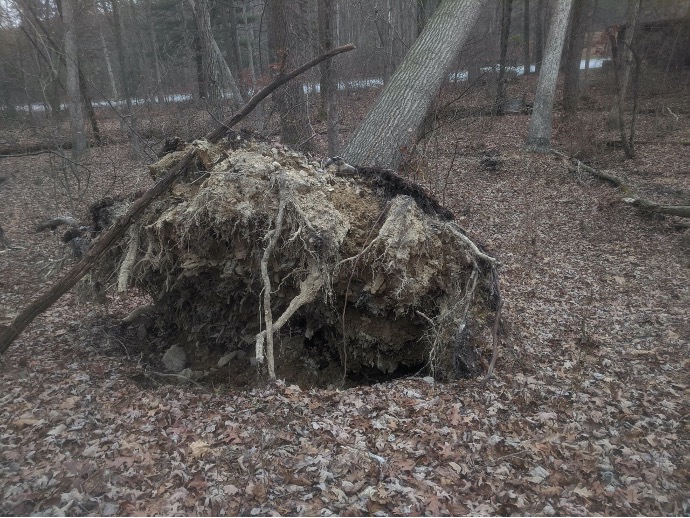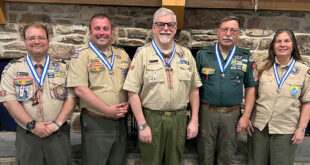
The health and safety of our Scouts, leaders, and Scouting families is always our highest priority. This focus has been at the forefront as we have sought to navigate the current COVID-19 pandemic safely. Now, as we’ve been able to resume some Scouting activities, we face a new health and safety challenge – this time at Camp Tuckahoe and, specifically, an unacceptable risk of injury from falling trees caused by unseen root damage to many of the trees at camp.
On October 20, the Council’s Executive Board unanimously decided to close Tuckahoe indefinitely due to concerns about certain species of trees, primarily scarlet oaks, in the campsites and primary use areas. As you might imagine, closing any Scout camp for all activities is not a decision made lightly. It is essential to explain why the Executive Board made this difficult choice.
Over the past few years, we have seen a surprising and increasing number of large trees, primarily scarlet oaks, come down at Tuckahoe. These trees were fully “leafed out” and looked perfectly normal and healthy before they toppled over in storms. One of these trees struck Hemlock Lodge in the spring of 2019, badly damaging its roof. Another tree fell on Pine Lodge in the fall of 2019, causing so much damage that the structure had to be torn down and replaced.
This year, we had another 25 large trees throughout the camp come down in a single storm in late August. While it’s undoubtedly true that trees fall over in the woods, the number of what appeared to be visibly healthy trees coming down was a mystery. Our volunteers and rangers monitor the trees at our camps, and we routinely remove visibly dead and dying trees in campsites and primary use areas.
To help determine what was going on with these trees, we received some help from Dr. David Foster, a biology and environmental science professor at Messiah University and former Council Commissioner of the New Birth of Freedom Council. With the assistance of some of his students, Dr. Foster led an extensive survey of Tuckahoe’s wildlife and conditions, including the problematic trees. Matt Kern, Service Forester for York and Adams Counties from the Pennsylvania Department of Conversation and Natural Resources, Bureau of Forestry, also participated in this work.
Dr. Foster’s findings were presented to the Executive Board on October 20 and help to identify multiple factors contributing to the growing number of trees coming down, including:
- The scarlet oaks at Tuckahoe are the primary concern. Many of the camp’s scarlet oaks are more than 150 years old, and some are nearly 100 feet tall and weigh approximately six tons. In examining the root masses of fallen scarlet oaks, the roots are dramatically undersized for the tree’s sheer size, and root rot fungus was visible in these trees.
- In combination with an already high groundwater table in the area, 2019 was also a year of historic rain levels. When combined with the unstable clay soils at Tuckahoe, these large scarlet oaks (with their undersized roots) are not anchored well enough in the ground and become more susceptible to being toppled in storms and high winds.

It is impossible to treat or correct the issues contributing to this root rot fungus and smaller root balls in these scarlet oaks. With an abundance of caution, the Executive Board elected not to permit any camping or activities at the camp indefinitely. A special task force will guide our actions to remedy the situation and will assess under what conditions we can reopen.
Dr. Foster’s recommendations to the Executive Board include removing all of the large scarlet oaks over 12″ in diameter in campsites and primary use areas. Our goal is to complete that process in time for summer camp next year. If it is possible to reopen parts of Tuckahoe earlier safely, we will try to do so.

This effort will be a big job, spread out over roughly 235 acres. We are currently hiring a consulting forester to mark specific trees, handle the bidding process, and manage the harvest itself. Unfortunately, scarlet oaks are the predominant tree species in the campsites and primary use areas, and this work will undoubtedly change Tuckahoe’s appearance, at least in the short run.
Financially, it’s our hope right now that the value of the timber removed will cover the costs that the Council will incur to clean up and make any necessary improvements. This work would include replanting new species of trees better suited to the conditions and adding ground cover that will grow well once we open up the tree canopy to allow more sunlight to reach the ground. As we often teach in Scouting, with some problems, there are also opportunities.
We will be providing additional information as soon as possible, but I wanted to get this initial information out to everyone just as quickly as we could. Our Camping Department will be contacting units with reservations for campsites and cabins at Tuckahoe. We hope to accommodate as many of these reservations as possible at either Hidden Valley or Conewago. But if units would prefer to receive a refund, we’ll gladly do that as well.
Yours in Scouting,
Ron Gardner
Scout Executive & CEO
 ARCHIVE – New Birth of Freedom Council, BSA Website for the New Birth of Freedom Council, BSA
ARCHIVE – New Birth of Freedom Council, BSA Website for the New Birth of Freedom Council, BSA
